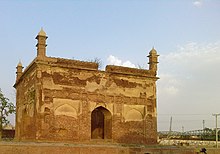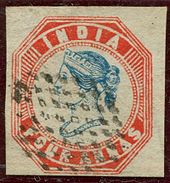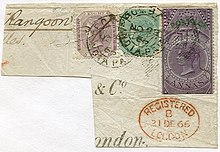Postage stamps and postal history of India
When the Portuguese, Dutch, French, Danish and British conquered the Marathas who had already defeated the Mughals, their postal systems existed alongside those of many somewhat independent states.
Although the Indian Post Office was established in 1837, Asia's first adhesive stamp, the Scinde Dawk, was introduced in 1852 by Sir Bartle Frere, the East India Company's administrator of the province of Sind.
The antecedents have been traced to the systems of the Persian Empire instituted by Cyrus the Great and Darius I for communicating important military and political information.
The Atharvaveda (or Arthveda) which is one of the oldest books in the world, records a messenger service in ancient India millenniums ago.
Systems for collecting information and revenue data from the provinces are mentioned in Chanakya's Arthashastra (meaning military strategy and skill)(c. 3rd century BCE).
[4] In the South of India, in 1672 Raja Chuk Deo of Mysore began an efficient postal service which was further improved upon by Haider Ali.
[6] After 1793, when Cornwallis introduced the Regulation of the Permanent Settlement, the financial responsibility for maintaining the official posts rested with the zamindars.
Each mail-bag is conveyed by an hurkaru (or runner) who is attended by one or two doogy-wallahs, or drummers, who keep up a kind of long-roll, as they pass any suspicious place.
This route, pioneered by Thomas Waghorn,[11] linked the Red Sea with the Mediterranean, and thence by steamer via Marseille, Brindisi or Trieste to European destinations.
A year earlier Sir Bartle Frere had replaced the postal runners with a network of horses and camels, improving communications in the Indus river valley to serve the military and commercial needs of the British East India Company.
The shape was circular, with "SCINDE DISTRICT DAWK" around the rim and the British East India Company's Merchant's Mark as the central emblem.
The 4 annas value (illustrated) was one of the world's first bicolored stamps, preceded only by the Basel Dove, a beautiful local issue.
In the opinion of Geoffrey Clarke, the reformed system was to be maintained "for the benefit of the people of India and not for the purpose of swelling the revenue.
It introduced "low and uniform" rates for sending mail efficiently throughout the country within the jurisdiction of the East India Company.
A new design for stamps, with Queen Victoria in an oval vignette inside a rectangular frame, was inscribed "EAST INDIA POSTAGE".
These stamps were recess printed by De La Rue in England (who produced all the subsequent issues of British India until 1925).
The Post Office Act XIV introduced reforms by 1 May 1866 to correct some of the more apparent postal system deficiencies and abuses.
Three stamps, featuring a detail from Heinrich von Angeli's 1885 portrait of Queen Victoria,[23] in 2, 3 and 5 rupee denominations, were introduced in 1895.
In 1902 a new series depicting King Edward VII generally reused the frames of the Victoria stamps, with some color changes, and included values up to 25 rupees.
Generally, such usage will lower a collector's estimation of a stamp's value; except those from remote or "used abroad" offices.
The stamps issued in 1937 depicted various forms of mail transports, with King George VI's effigy appearing on the higher values.
A new issue in 1941, constrained by the austerity of World War II, consisted of rather plain designs using minimal amounts of ink and paper.
The possibility of printing postage stamps and other security items in India had been enquired into before the First World War but could not be pursued at that time.
Their favourable report, followed by a successful demonstration of production techniques in Delhi in 1923, led to the decision of the Government to establish a security press at Nashik.
The responsibility of setting up the Press was entrusted to none other than the London firm of Thomas De La Rue which already had a six-decade long association with Indian stamps.
The first stamps produced were the definitive series of George V, printed using typography from the same plates used earlier in England by De La Rue, which were now transferred to India.
It depicts the Indian Flag with the patriots' slogan, Jai Hind (Long Live India), on the top right hand corner.
Exactly one year later a definitive series appeared, depicting India's broad cultural heritage, mostly Hindu, Buddhist, Muslim, Sikh and Jain temples, sculptures, monuments and fortresses.
Countries which have had stamps printed in India include Burma (before independence), Nepal, Bangladesh, Bhutan, Portugal, and Ethiopia.
[citation needed] This proliferation of offices results from India's history of having many disparate postal systems, eventually unified in the Indian Union after Independence.







an 1856 color imprimatur ,
2 annas "bottle green"








